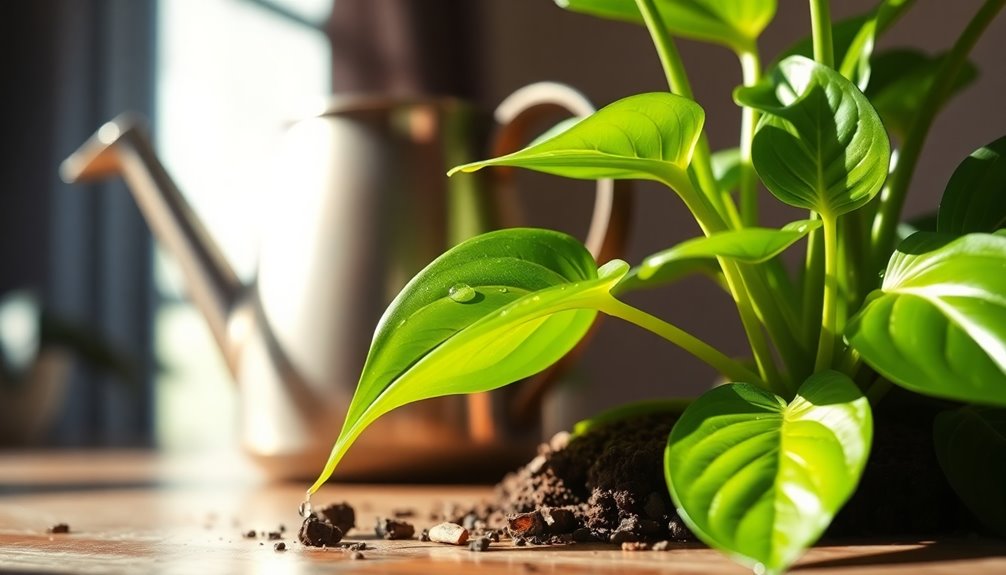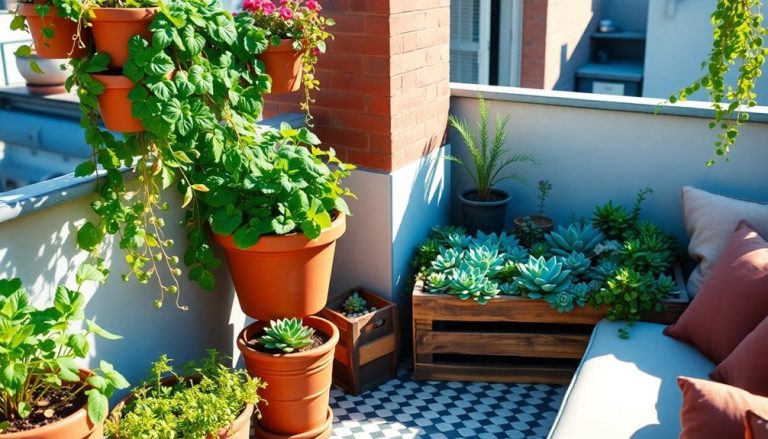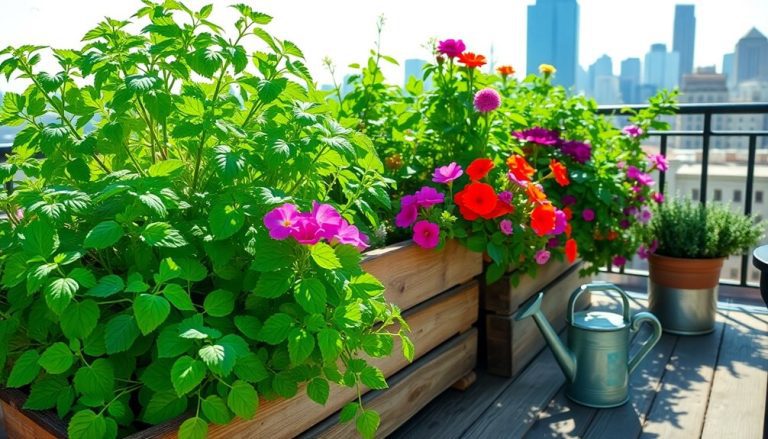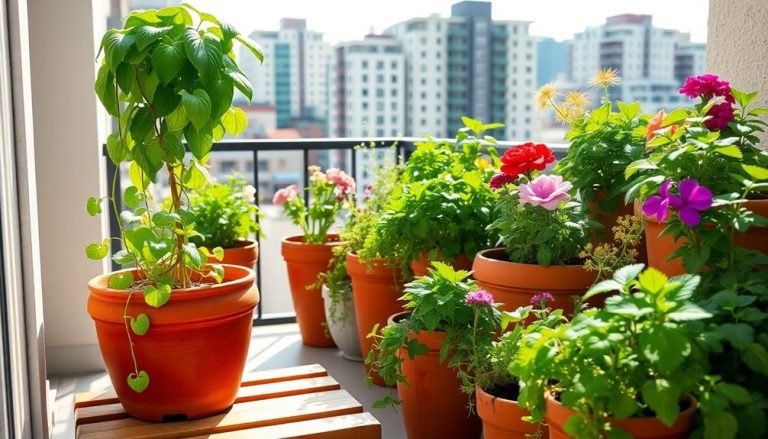To properly water your houseplants, start by understanding their unique needs. Check soil moisture regularly using the finger test or a moisture meter. Always use room temperature water and ensure you water thoroughly and evenly. Be aware of seasonal changes; many plants need more water in spring and summer. Pay attention to drainage to prevent root rot. If you're growing tropical plants, mist or increase humidity when necessary. Avoid a strict watering schedule—instead, observe your plants closely and adjust as needed. Stick around to discover more tips that can help your plants thrive!
Key Takeaways
- Check soil moisture regularly using the finger test or moisture meters to determine when to water your plants.
- Use room temperature water to prevent root shock and water thoroughly to saturate the root zone.
- Adjust watering frequency based on seasonal changes, as plants require more water during the growth season than in winter.
- Ensure containers have adequate drainage holes and use well-draining potting mix to prevent root rot.
- Monitor plant health for signs of overwatering or underwatering, such as yellowing leaves or browning tips.
Understand Your Plant's Needs
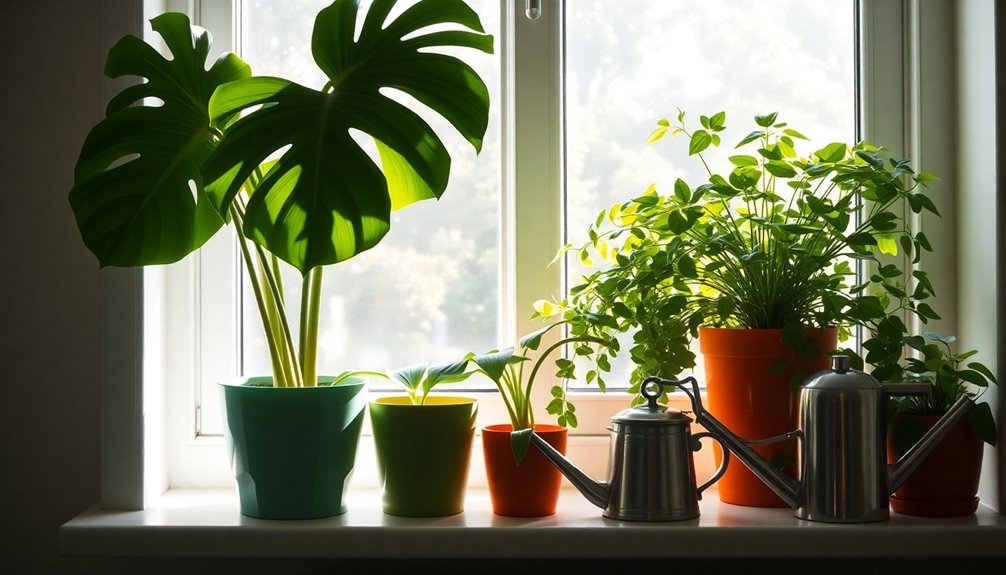
Each plant species has its unique watering requirements, so it's crucial to understand what yours needs. Start by researching your specific plant type. Some thrive in consistently moist soil, while others prefer to dry out between waterings. This knowledge helps you create a tailored watering schedule. Additionally, using a seedling heat mat can promote consistent moisture levels by maintaining optimal soil temperature for healthy root growth.
Next, consider the size of the pot and the type of soil you're using. Smaller pots can dry out faster, while well-draining soil may require more frequent watering.
You should also take into account the plant's environment. For instance, plants in bright, warm spots generally need more water than those in cooler, shadier areas.
Don't forget to observe your plant's appearance. If the leaves are wilting or turning yellow, it might be a sign of overwatering or underwatering. Similarly, new growth can indicate that your plant is happy with its current watering routine.
Finally, seasons affect watering needs too. During the growing season, your plant may require more water, while in winter, it might need less. Additionally, using self-watering planters can help regulate moisture levels and reduce the frequency of watering.
Check Soil Moisture Regularly
To keep your houseplants healthy, checking soil moisture regularly is essential. Overwatering or underwatering can lead to various issues, like root rot or dehydration.
So, how do you know when it's time to water? Start by sticking your finger about an inch into the soil. If it feels dry, it's time to give your plant some water. If it's still moist, wait a few days and check again.
You might also consider using a moisture meter for more accurate readings. These handy tools can help you gauge the moisture level without guessing. Soil moisture sensors can provide even more detailed insights into your plants' needs. Proper watering is especially crucial for succulents, which require specific moisture levels to thrive.
Remember, different plants have different needs, so pay attention to their specific requirements.
Additionally, observe your plants for signs of stress. Yellowing leaves often indicate overwatering, while drooping leaves can show that your plant needs water.
Make checking soil moisture a regular part of your plant care routine. Set reminders or make it a habit to check every week.
Use the Right Water Temperature
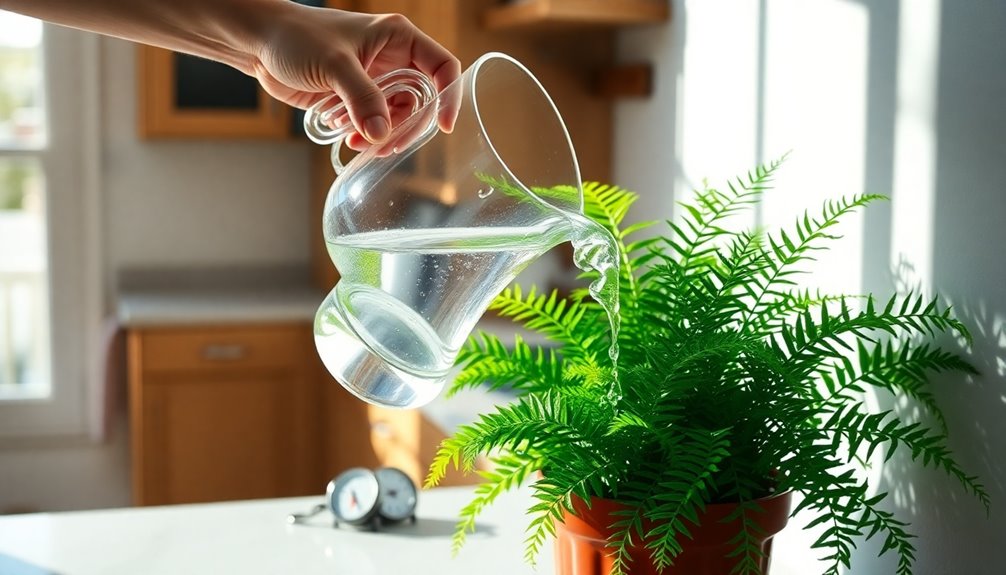
After ensuring your plants' soil moisture is just right, consider the temperature of the water you use. Water temperature can greatly impact your plants' health. Using water that's too cold can shock the roots, while water that's too warm might encourage root rot. Aim for a comfortable temperature that mimics natural rainfall, generally around room temperature. Additionally, choosing high-quality plant food online can support your plants' overall health, making them more resilient to temperature changes. To further enhance your plants' vitality, consider using fertilizer tablets that provide essential nutrients directly to the roots.
Here are some tips to keep in mind:
- Use room temperature water to avoid shocking the roots.
- Avoid cold tap water; it can be jarring for your plants.
- Warm up water slightly if you've just taken it from a cold place, but don't make it hot.
- Test the water with your wrist; it should feel neither cold nor hot.
Water Thoroughly and Evenly
Watering your houseplants thoroughly and evenly is crucial for their overall health and growth. When you provide water, aim to saturate the soil completely, allowing it to reach the root zone where it's most needed. This ensures that your plants receive adequate moisture and nutrients. A high-quality garden hose can help make watering your plants more efficient and effective, especially for larger areas.
Here's a quick guide to help you understand how to water effectively:
| Key Aspect | Tips |
|---|---|
| Frequency | Water when the top inch of soil feels dry. |
| Amount | Ensure water runs out of the drainage holes. |
| Technique | Use a watering can with a spout for precision. |
| Observation | Check for wilting or yellowing leaves as signs of need. |
Don't rush the process; let the water soak in slowly to prevent runoff. By watering evenly, you avoid creating dry spots in the soil, which can lead to uneven growth and stress your plants. Additionally, consider using plant watering globes to help maintain consistent moisture levels in your pots. Remember, consistency is key. Over time, you'll develop a routine that suits both your plants and your schedule, ensuring they thrive in your care.
Adjust for Seasonal Changes
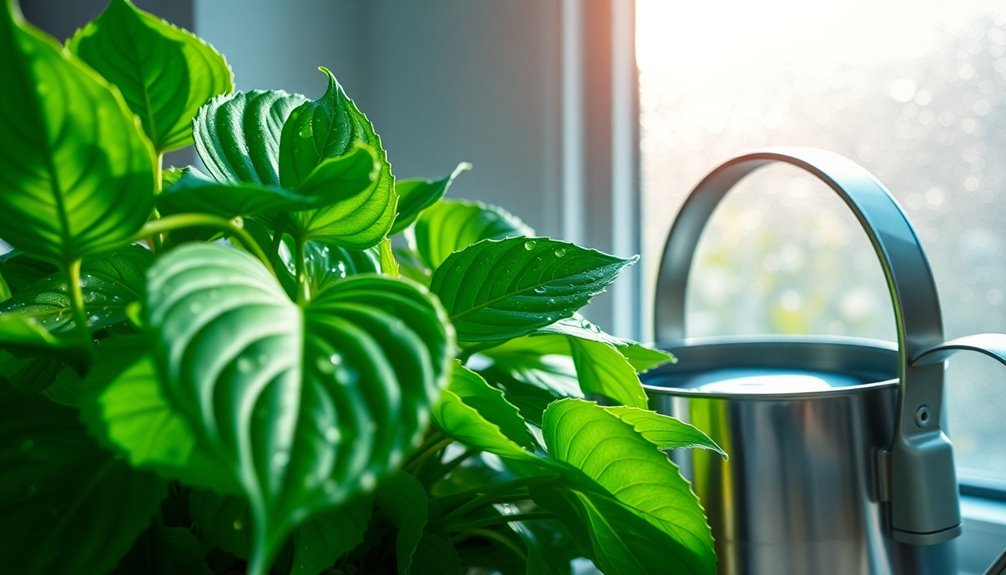
As you develop your watering routine, be mindful that the needs of your houseplants can change with the seasons. In winter, for example, many plants enter a dormant phase. They require less water due to reduced light and cooler temperatures. During this time, using solar lighting solutions can help provide the necessary light for certain plants that may need it.
Conversely, during spring and summer, when growth is in full swing, your plants will need more frequent watering to support their active growth.
Here are some key points to remember:
- Light Exposure: Longer days in spring and summer mean your plants will photosynthesize more and need additional water.
- Humidity Levels: Winter often brings dry air from heating systems, which can dry out your plants faster.
- Temperature Fluctuations: Higher temperatures can lead to quicker evaporation, requiring you to check moisture levels more often.
- Plant Types: Different plants have varying needs; tropical plants may thrive in summer but struggle in winter.
Additionally, investing in greenhouse essentials can help maintain optimal conditions for your houseplants throughout the year.
Choose the Right Container
Selecting the right container for your houseplants can significantly impact their health and growth. When you choose a container, consider the size, material, and style. A pot that's too small can restrict root development, while one that's too large may retain excess moisture, leading to root rot. Aim for a pot that allows the roots to grow comfortably without being cramped.
Material matters too. Terracotta pots are porous and can help with evaporation, making them ideal for plants that prefer drier conditions. On the other hand, plastic pots retain moisture better and are lighter, which can be a plus for larger plants. Think about your plant's needs when deciding.
Lastly, don't forget about aesthetics. You want a container that complements your home decor while providing a suitable environment for your plants. If you're unsure, choose a simple design that matches your style.
Pay Attention to Drainage
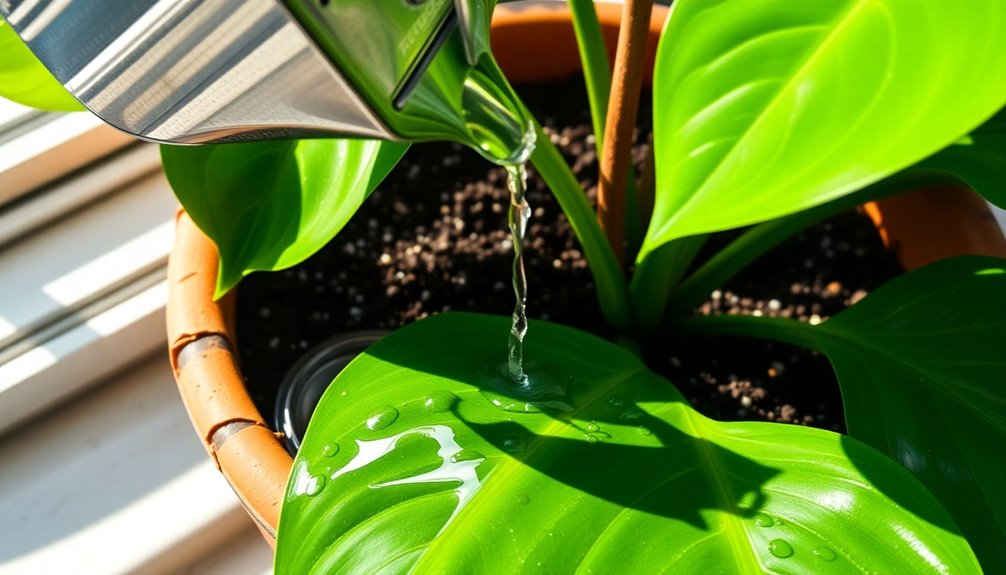
Choosing the right container is only part of the equation for keeping your houseplants healthy; paying attention to drainage is equally important.
Good drainage allows excess water to escape, preventing root rot and other issues that can arise from soggy soil.
Here's what you should consider:
- Drainage holes: Ensure your pot has adequate drainage holes at the bottom.
- Potting mix: Use a well-draining potting mix that facilitates water flow while retaining some moisture.
- Elevation: Elevate your pots slightly off the ground using saucers or pot feet to enhance drainage.
- Check regularly: Monitor the drainage system to ensure it's not clogged by roots or debris.
Mist or Humidify When Necessary
To keep your houseplants thriving, don't overlook the importance of misting or humidifying when necessary. Many houseplants, especially tropical varieties, prefer higher humidity levels than what's typically found indoors.
If your home is dry, especially during winter, you might notice your plants struggling. Misting your plants can help increase humidity and provide a refreshing boost. Use a spray bottle to lightly mist the leaves, focusing on the undersides where many plants absorb moisture.
However, be careful not to overdo it; too much moisture can lead to mold or mildew. Alternatively, consider investing in a humidifier. A small unit can work wonders, especially if you have multiple plants or a designated plant area.
Placing a tray filled with water and pebbles near your plants can also create a micro-humid environment. Keep an eye on your plants' leaves. If they start to brown or curl, it might be a sign that they need more humidity.
Regularly assess your environment, and don't hesitate to adjust your misting or humidifying routine to keep your plants happy and healthy.
Avoid Watering on a Schedule
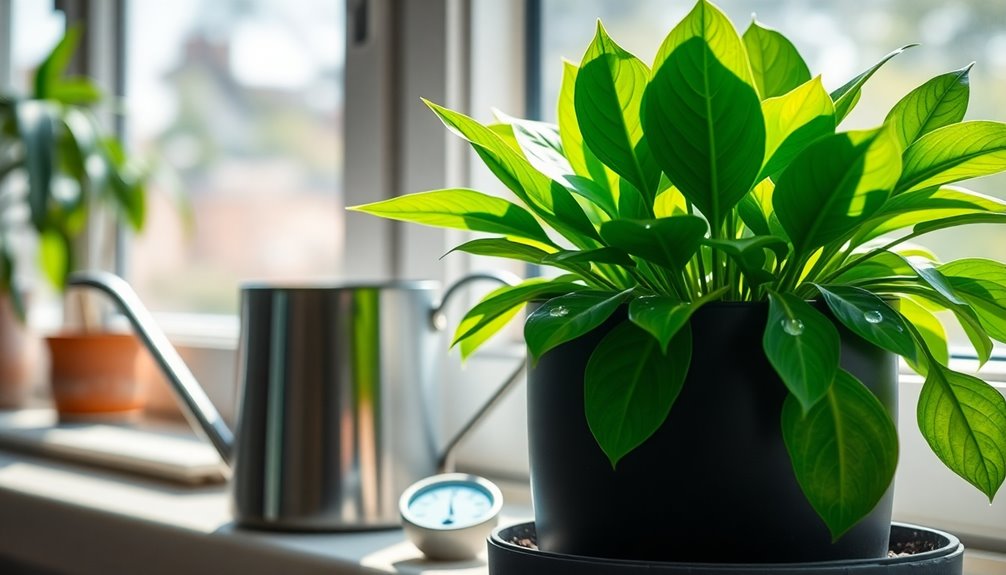
Many plant owners make the mistake of watering their houseplants on a strict schedule, but this can lead to problems.
Plants need different amounts of water based on their environment, growth stage, and species. By sticking to a routine, you might be overwatering or underwatering your plants, which can cause stress and health issues.
Here are some factors to consider instead of a rigid schedule:
- Seasonal changes: Plants require more water in the growing season and less during dormancy.
- Soil type: Different soils retain moisture differently—some dry out quickly while others stay wet longer.
- Humidity levels: Higher humidity can reduce the need for watering, while dry air can increase it.
- Pot size and drainage: Smaller pots may dry out quicker, and proper drainage prevents water from sitting at the bottom.
Instead of relying on a set timetable, check the soil moisture regularly and adjust your watering practices accordingly.
This approach helps you meet your plant's unique needs and keeps them healthy and thriving.
Observe Plant Health Closely
Monitoring your plants' health closely is just as important as adjusting your watering habits. By keeping an eye on your plants, you'll notice early signs of stress that could indicate over- or under-watering. Look for yellowing leaves, which often signal too much water, while browning tips may mean they're thirsty.
Pay attention to the soil as well. If it stays soggy for too long, it might lead to root rot. Conversely, soil that dries out too quickly can hamper your plant's growth. Adjust your watering frequency based on these observations rather than sticking rigidly to a schedule.
Another factor to consider is your plant's growth rate. If it's growing rapidly, it may need more water than a dormant plant. Similarly, seasonal changes can affect how much water your plants require.
Lastly, don't forget to check for pests or diseases, which can also affect your plant's health. By observing your plants closely and responding to their needs, you'll develop a better understanding of their watering requirements, leading to a thriving indoor garden.
Frequently Asked Questions
How Often Should I Repot My Houseplants?
You should repot your houseplants every 1-2 years, or whenever they outgrow their containers. Signs include roots growing through the drainage holes or stunted growth. Always choose a pot slightly larger than the current one.
Can I Use Tap Water for My Plants?
When it comes to using tap water for your plants, you're walking a fine line. Most houseplants can handle it, but let it sit for a day to dissipate chlorine and prevent any potential harm.
What Signs Indicate Overwatering or Underwatering?
You'll notice signs of overwatering, like yellowing leaves and root rot, while underwatering manifests as dry, crispy leaves and wilting. Keep an eye on your plant's overall health to adjust your watering routine accordingly.
Are There Specific Plants That Need More Humidity?
Yes, certain plants thrive in higher humidity. Tropical species like ferns, orchids, and peace lilies often need more moisture in the air. You'll notice improved growth and vitality when you increase humidity levels for them.
How Can I Tell if My Plant Needs Fertilizer?
Fertilizer frequency fuels flourishing foliage. You'll notice your plant's leaves fading, growth slowing, or becoming sparse. If it looks lackluster, it's likely time to feed it. Keep an eye out for these telltale signs!
Conclusion
Just like a well-tended garden flourishes under care, your houseplants thrive with your attention. By understanding their unique needs and nurturing them with the right amount of water, you're not just feeding them; you're cultivating a bond. Each drop you give symbolizes your commitment to their growth. So, take a moment to observe and connect with your plants. In doing so, you nurture not only their lives but also your own, fostering a flourishing environment for both.

